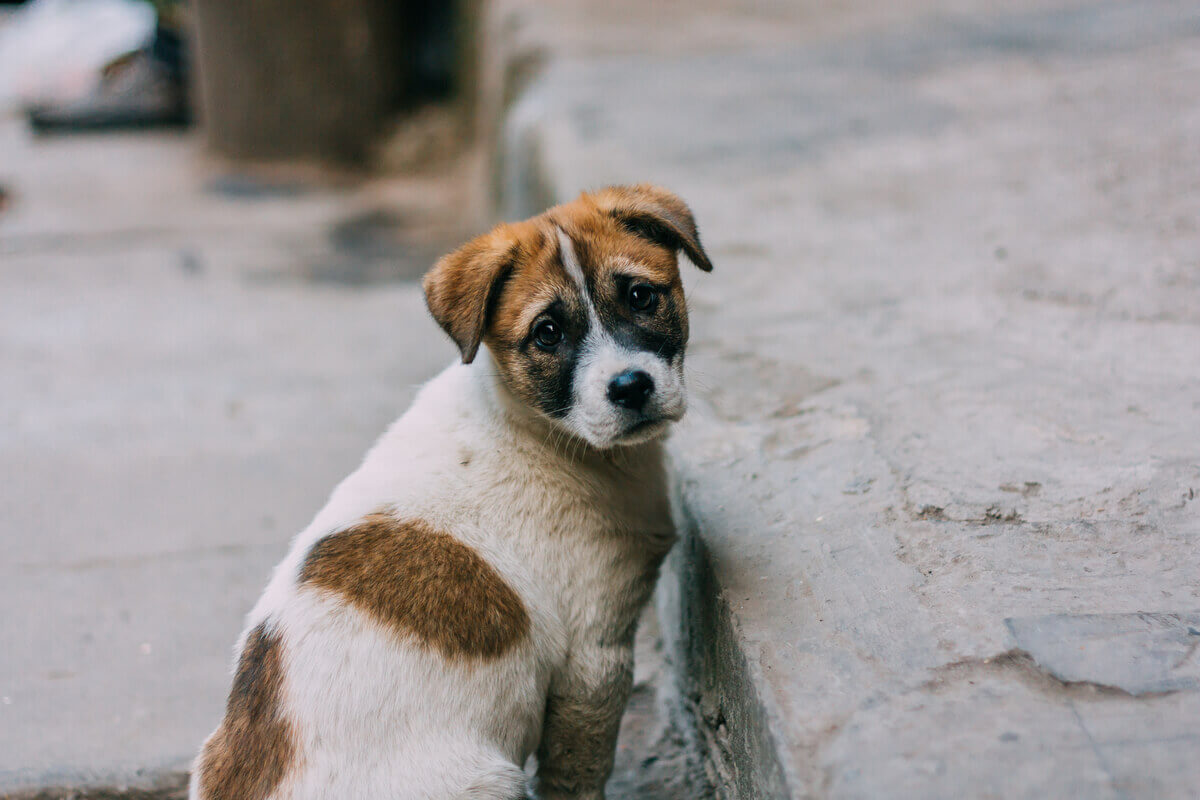City Dogs Are More Socially Fearful than Rural Dogs

Cities, with all their hustle and bustle and stress, influence the behavior and perception of more species than just humans. A study published last year alludes to the fears of city dogs, which develop more social anxiety than those in the countryside for various reasons.
Below, you can read the review of this article, which isn’t limited to the living environment but analyzes more factors that influence the social fears of dogs. Keep reading, because its findings are really interesting.
Fears of city dogs
The University of Helsinki wanted to determine what factors predispose dogs to suffer from social fear in a study in the journal Nature published in 2020. To this end, data was collected from almost 6,000 dogs selected from a larger sample of 14,000 canines.
The study showed that inadequate socialization of puppies is the main cause of social fear. However, it was also noted that the environment in which the dogs live seems to play a role, with owners reporting that urban dogs are more fearful than rural dogs.
The fears of urban dogs tend to be social: Fear of strangers, other dogs, or being outdoors. Many of them were also particularly sensitive to loud noises, such as passing cars, the sound of construction work, or the roar of fireworks.
City life exposes dogs to sounds that they would not have to face in their natural environment.

Risk factors for the fears of city dogs
The study that we’ve cited in the previous lines extracted from the surveys the factors most related to the fears of city dogs. The most relevant are the following:
- Sex: Social fear was more common among females than males.
- Castration: Neutered dogs were found to be more fearful, probably due to hormonal imbalances resulting from the removal of the gonads.
- Size: Small canines tended to be more socially fearful, as some may well be at a disadvantage to larger breeds.
- Activity: Owners of fearful dogs engaged them in activities and training much less frequently than less fearful dogs. However, it’s not clear to the authors whether activity is a cause or a consequence of this.
- Handler training style: If exposure to new situations plays a role in a dog’s attitude to stressful stimuli, it’s possible that handlers who keep their dogs away from them are conditioning them.
- Socialization: Dogs that hadn’t learned to socialize properly with others of their own kind and with humans had a more fearful temperament than those that interacted properly.
- Breed: Selective breeding of certain breeds for specific personalities (such as guard dogs) makes some breeds more able to cope with stressful situations than others.
- Environment: City life has been shown to produce high levels of stress in humans. Dogs more sensitive to noisy and frenetic environments were also found to be more sensitive to developing social fears.
Why rural dogs aren’t as afraid
The differences between the fears of city and rural dogs didn’t yield strong results in the study cited above. Geographic location, for example, detracted somewhat from the consistency of the conclusions, as there are quieter cities and rural areas with many stressors.
However, what’s clear is that rural dogs aren’t exposed to certain environmental toxins, environmental stress, or social isolation. Especially in interaction with humans, these factors seem to be related to the causation of fear.
Dogs that are sensitive to overstimulation and sudden loud noises may do better in a rural environment where encounters with people and other animals are less frequent. However, this is an aspect that needs to be studied further to establish firm causalities.
How to help dogs overcome fear?
The study also includes some tools to improve the welfare of dogs in the area of socialization and phobias. The researchers insist that exposure to different stimuli in puppyhood and an active lifestyle can significantly decrease social phobia.
If the fears of city dogs are already established in the dog, the best technique to help it will be progressive exposure to stressful stimuli. In any case, it’s always important to let the dog set the pace. With positive reinforcement and patience, pets can be made to lose their fears.
The bravest breeds
As mentioned above, genes have an effect on a dog’s sensitivity. Genetics have also been linked to the propensity to develop certain behavioral disorders, such as separation anxiety, territoriality, or overprotectiveness. The study sheds light on this issue and points out the breeds that are less likely to develop the typical fears of city dogs:
- Wheaten terrier: Originally bred to control rat infestations on farms in Ireland.
- Cairn terrier.
- Pembroke Welsh Corgi: Both this breed and the previous one were among the best socialized.
On the other hand, breeds such as the Spanish Water Dog or the Shetland Shepherd (Sheltie) were among those that expressed the most social fear. It should be noted, however, that when choosing a dog to live in the city, the breed is only one of many factors that influence their personality. Any well-socialized animal can be happy by your side wherever you are.

With this study, it’s clear that the fears and stressors experienced are very different in dogs depending on the environment analyzed. The results don’t mean that a dog can’t live at ease in the city, but exposing the pet to certain aggressive stimuli typical of the city isn’t necessary.
All cited sources were thoroughly reviewed by our team to ensure their quality, reliability, currency, and validity. The bibliography of this article was considered reliable and of academic or scientific accuracy.
- Puurunen, J., Hakanen, E., Salonen, M.K. et al. Inadequate socialisation, inactivity, and urban living environment are associated with social fearfulness in pet dogs. Sci Rep 10, 3527 (2020). https://doi.org/10.1038/s41598-020-60546-w
- Vanrell Valls, M., García-Belenguer Laita, S., & Luño Muniesa, I. Miedo y fobia social en la especie canina: a propósito de un caso clínico.
This text is provided for informational purposes only and does not replace consultation with a professional. If in doubt, consult your specialist.